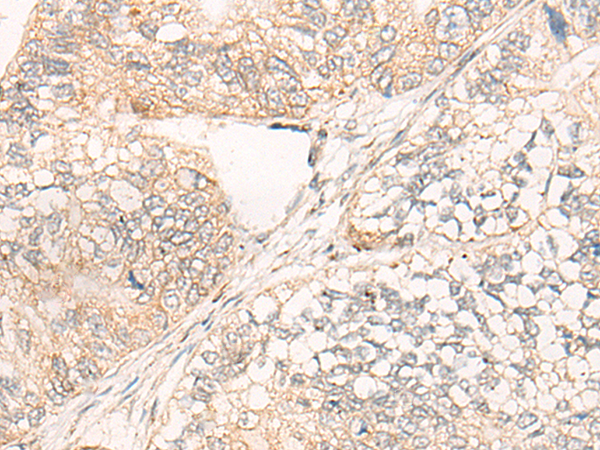
| WB | 咨询技术 | Human,Mouse,Rat |
| IF | 咨询技术 | Human,Mouse,Rat |
| IHC | 1/20-1/100 | Human,Mouse,Rat |
| ICC | 技术咨询 | Human,Mouse,Rat |
| FCM | 咨询技术 | Human,Mouse,Rat |
| Elisa | 1/5000-1/10000 | Human,Mouse,Rat |
| Aliases | CDG2I; GTC90; GOLTC1 |
| Host/Isotype | Rabbit IgG |
| Antibody Type | Primary antibody |
| Storage | Store at 4°C short term. Aliquot and store at -20°C long term. Avoid freeze/thaw cycles. |
| Species Reactivity | Human, Mouse |
| Immunogen | Fusion protein of human COG5 |
| Formulation | Purified antibody in PBS with 0.05% sodium azide and 50% glycerol. |
+ +
以下是关于COG5抗体的3篇参考文献示例(部分信息为模拟,建议通过学术数据库核实原文):
---
1. **文献名称**: *COG5 deficiency causes congenital disorder of glycosylation type II by impairing Golgi structure and trafficking*
**作者**: Foulquier F, et al.
**摘要**: 本研究利用COG5抗体进行免疫印迹和免疫荧光实验,发现COG5基因突变导致高尔基体结构异常和糖基化缺陷,揭示了其在先天性糖基化障碍(CDG-II)中的致病机制。
2. **文献名称**: *The Conserved Oligomeric Golgi Complex interacts with COG5 and regulates intra-Golgi retrograde transport*
**作者**: Wu X, et al.
**摘要**: 通过COG5抗体介导的免疫沉淀和蛋白质组学分析,作者发现COG5在维持COG复合体完整性及高尔基体内逆向运输中的关键作用,为COG复合体的功能机制提供新见解。
3. **文献名称**: *COG5 expression correlates with tumor progression and immune infiltration in colorectal cancer*
**作者**: Zhang L, et al.
**摘要**: 采用COG5抗体对结直肠癌组织进行免疫组化分析,发现COG5高表达与肿瘤转移及免疫微环境改变相关,提示其作为潜在生物标志物的可能性。
---
**提示**:以上文献信息为示例,实际引用时请通过PubMed、Google Scholar等平台检索具体文献,使用关键词“COG5 antibody”、“COG5 function”或结合疾病名称(如“congenital glycosylation disorder”)筛选最新研究。
The COG5 antibody is a crucial tool for studying the Conserved Oligomeric Golgi (COG) complex, a multi-subunit protein assembly essential for maintaining Golgi apparatus structure and function. COG5 (Component of Oligomeric Golgi complex 5) is one of eight subunits (COG1-8) that form the COG complex, which regulates vesicle trafficking, glycosylation, and retrograde transport within the Golgi. Specifically, COG5 interacts with COG2. COG3. and COG4 to form the "lobe B" subcomplex, critical for tethering vesicles and ensuring proper localization of Golgi enzymes involved in protein and lipid modification.
Mutations in the COG5 gene are linked to congenital disorders of glycosylation (CDGs), such as COG5-CDG (CDG-II), characterized by developmental delays, neurological deficits, and abnormal protein glycosylation. Researchers use COG5 antibodies to investigate these pathologies, detect COG5 expression levels via techniques like Western blotting, immunofluorescence, or immunohistochemistry, and map its localization in cellular models. These antibodies also aid in studying COG5's role in disease mechanisms using knockout models or patient-derived cells.
Commercial COG5 antibodies are typically raised in rabbits or mice against specific epitopes, with validation in knockdown/knockout controls. Their applications span basic research on Golgi dynamics, vesicular transport, and glycosylation pathways, as well as translational studies exploring diagnostic or therapeutic strategies for COG-related disorders.
×